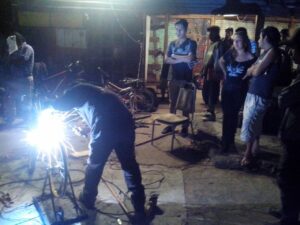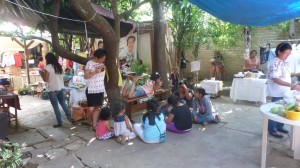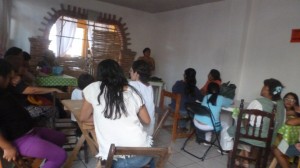Engaged Anthropology Grant: Maurice Rafael Magana

Maurice Rafael Magana is an Assistant Professor of Anthropology at The University of Arizona. In 2010 while a doctoral student at the University of Oregon he received a Dissertation Fieldwork Grant to aid research on “Contentious Walls: The Cultural Politics of Social Movement Street Art in Southern Mexico,” supervised by Dr. Lynn Stephen. In 2014 Dr. Magana received an Engaged Anthropology Grant to aid engaged activities on “Youth Activism, Anthropology, and Community Building in Oaxaca, Mexico”.
After receiving the great news that I was awarded an Engaged Anthropology Grant from the Wenner-Gren Foundation, I began the challenging process of organizing a collaborative community engagement event in Southern Mexico from my home in Los Angeles. I carried out my dissertation research in Oaxaca City with a network of youth organizers who had participated in a broad-based social movement in 2006. Although crucial to the social movement, the contributions of youth were largely trivialized or ignored by most media and scholarly accounts, which often perpetuate narratives about the political apathy and criminality of Mexican youth. The idea behind the event was to create a space that foregrounded the experiences of youth in the movement, while also bringing together older community members to create an intergenerational space for collective reflection on the movement’s impacts. In addition to the community event, I also presented my research findings to scholars in two separate forums.
After several rounds of emails and social media communication with my collaborators, I decided that the only way the project was going to move forward and maintain its collaborative spirit was by sitting down with my collaborators face-to-face. I flew to Oaxaca in the spring of 2015 in order to concretize our plans for the event. I met with a group of activists representing four different youth collectives that I worked with in my previous research. We decided that given the current state of movement networks (which looked very different than they had during my fieldwork in 2010-2011), the best plan was to hold several smaller events instead of one large event. After meeting two more times we agreed to schedule the events for September of 2015 and continue planning them through regular email and Facebook messaging. While in Oaxaca on this planning trip, I also presented my research to a group of about forty Mexican and international scholars and students at the Institute of Oaxacan Culture. I focused on the ethical and methodological dilemmas of conducting engaged research with decentralized networks of leaderless (or leaderful) movements.

When I returned to Oaxaca in September, the first event was a forum with a punk collective held in a community gallery located in a working class neighborhood in the outskirts of Oaxaca. During the social movement, this collective helped create spaces of refuge for community members fleeing police repression. This introduced the punks to their neighbors- many of whom had previously harbored prejudice against the youth because of their appearance and cultural practices. The forum was an opportunity for the punks to reconnect with some of their neighbors and let them know about the work they were doing, specifically as it related to the social movement of 2006. For example, one of the projects had to do with teaching low-income communities in the city and in rural areas to create their own pedal-powered machines like water pumps, blenders, knife sharpeners and washing machines.
We began the event by introducing ourselves to the audience of about thirty people. Two of my interlocutors shared a little about the collective, focusing on the role that anarchist and liberationist principles played in their organizing. I spoke briefly about my research project, highlighting the role of young people in the movement more broadly, and the role that youth associated with the punk collective played specifically. We then opened up the forum so that community members could offer their own reflections and analysis of the movement, as well as ask us questions. We had a rich discussion, with some healthy debate about what exactly had been gained by the movement- with members of the punk collective reflecting very positively about the experiences and memories of building community and reclaiming space during 2006, but feeling less positive about the current state of affairs in Oaxaca and Mexico more generally.

Four members of the collective then led a two-hour workshop for interested community members (about twenty people stayed ranging in age from teenagers to elderly but most were youth) about how to build a pedal-powered machine. This ended up being a great opportunity to strengthen and rekindle bonds made in 2006. We also exhibited photos of the collective from 2006 taken by a local photographer. The photographs sparked many conversations and memories about the extraordinary events that occurred in the context of the movement.
I also co-organized a forum and workshop with young women who had participated in a now-defunct social center that featured prominently in my research. The young women have gone on to found and participate in feminist, ecological and sustainable development initiatives. The forum highlighted the participation of women in the social movement and in social, cultural and political projects that have developed in the years since. My interlocutors also invited women from a more established women’s organization to join the conversation. This created a great collective and intergenerational space for reflection on the triumphs from 2006, as well as an honest and robust critique of the movement, especially around unequal gender politics and male domination within the movement. My interlocutors offered a nuanced analysis of the movement as creating social and political cleavages, which women expanded into spaces of belonging and participation. At the same time, they recognized the reproduction within the movement of many of the same social ills that they were fighting against, such as sexism, ageism and political opportunism. They understood the work that has followed around these issues as part of the legacy of 2006.
The young women offered two workshops after the forum. Two of the organizers led a workshop on how to repurpose glass bottles by cutting them using string and nail polish remover. Simultaneously, the other two interlocutors led a workshop on how to turn old t-shirts into shopping bags. The idea was to show people how to recycle old products, reduce consumption and waste and to save money. Importantly, in addition to being ecological initiatives, the collectives these young women belong to promote these kinds of workshops as practices of building autonomy from the dominant economic and political systems- much like the work of the punk collective described above. These workshops also attracted about twenty participants, but most were women and young children.
Finally, while in Oaxaca in September I also visited the local public university where I presented my research to a graduate seminar in anthropology. At the request of the students’ professor, this presentation focused on research design and fieldwork.
Taken together, the two forums and workshops created spaces for youth to engage their peers and older community members in ways that strengthened relationships that were forged in the context of the 2006 social movement. Moreover, I was able to present my research in these spaces in dialogue with my interlocutors, while highlighting their often-overlooked role in the movement. In addition to this, I was able to present my work to local academics and students in ways that were highly rewarding. As we approach the ten-year anniversary of the Oaxacan social movement of 2006, I feel that helping create spaces of reflection, collective knowledge production and analysis is an important way that I can honor the struggle and sacrifice of the communities that animate my research.